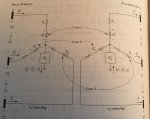General question:
when a single line to n or g equivilent ckt is drawn for analysis of a 3 ph ckt
with source and load, are both the load and n-g currents shown going INTO the load?
or line IN and l-g OUT, so a loop is formed
????
power in
x0 out
power out
x0 in
opposite sign
when a single line to n or g equivilent ckt is drawn for analysis of a 3 ph ckt
with source and load, are both the load and n-g currents shown going INTO the load?
or line IN and l-g OUT, so a loop is formed
????
power in
x0 out
power out
x0 in
opposite sign
Attachments
Last edited:


